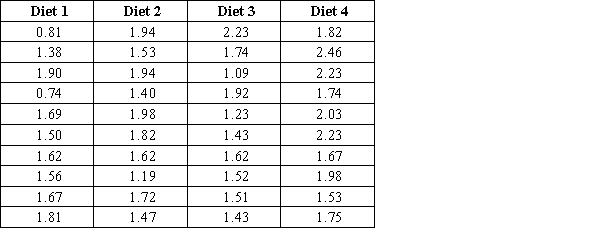Multiple Choice
Nutritionists study the impact of four different diets on women's vulnerability to vitamin B6 deficiency. The researchers randomly assigned adult women to one of four groups. Each group followed a specific diet. Let µ1, µ2, µ3, and µ4 represent the mean daily intake of vitamin B6 (in mg) for diets 1, 2, 3, and 4, respectively. The sample data are given in the table below. Use the 95% Tukey-Kramer procedure to identify the correct statement describing the differences among the diets. 
A) µ1 is significantly different from µ3 and there are no other significant differences.
B) µ4 is significantly different from both µ1 and µ3, and there are no other significant differences.
C) µ2 and µ4 are significantly different from µ1 and µ3. There are no other significant differences.
D) µ1 is significantly different from µ4 and there are no other significant differences.
E) µ2 is significantly different from both µ1 and µ3, and there are no other significant differences.
Correct Answer:

Verified
Correct Answer:
Verified
Q1: If the line segments in an interaction
Q2: When using the Tukey-Kramer multiple comparison procedure,
Q3: The test statistic for testing the equality
Q4: When using the 95% Tukey-Kramer procedure, in
Q5: Homogeneous groups of experimental units are called
Q7: In a two-factor ANOVA the main effects
Q8: Two factors A and B are said
Q9: A dairy scientist is studying three different
Q10: A comparison of the treatments based on
Q11: The Tukey-Kramer procedure controls the simultaneous confidence